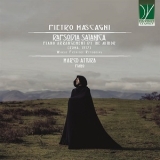1915 schrieb der italienische Komponist Pietro Mascagni eine bildsynchrone symphonische Begleitmusik zu Nino Oxilias Stummfilm Rapsodia Satanica, einem ‘dramma musicale cinematografico’, in dem Lyda Borelli die Hauptrolle spielte. Bei der Uraufführung am 3. Juli 1917 dirigierte Mascagni selber das Orchester im Kino Augusteo in Rom.
Die Komposition ist expressiv, farbenreich und illustriert im Film mit Leitmotivtechnik die Verflechtungen von Liebe und Tod.
Für dieses Da Vinci Classics-Album wurde der von Mascagni selbst erstellte Klavierauszug der Orchesterpartitur in seiner Gesamtheit und ohne Kürzungen aufgenommen. Die beigefügte Titelliste verweist auf die Untertitel des Films, so dass der Hörer die Möglichkeit hat, die Entwicklung des Films zu verfolgen bzw. sich diesen vorzustellen.
Nun ist Mascagnis Musik im orchestralen Original üppig, opulent, stimmungsvoll und auch sehr narrativ-illustrativ. Frank Strobel und die Deutsche Staatsphilharmonie Rheinland-Pfalz haben dies in ihrer Aufnahme für Capriccio gezeigt.
Diese Opulenz erreicht die Klavierversion natürlich nicht. Marco Attura spielt diese aber ausdrucksvoll und sehr inspiriert vom Bild, so dass man sich gut auf Themen und ihre Entwicklung konzentrieren kann.
In 1915, Italian composer Pietro Mascagni wrote a picture-synchronized symphonic score to Nino Oxilia’s silent film Rapsodia Satanica, a ‘dramma musicale cinematografico’ starring Lyda Borelli. At the premiere on July 3, 1917, Mascagni himself conducted the orchestra at the Augusteo Cinema in Rome.
The composition is expressive, rich in color, and uses leitmotif technique to illustrate the intertwining of love and death in the film.
For this Da Vinci Classics album, the piano reduction of the orchestral score, prepared by Mascagni himself, was recorded in its entirety and without cuts. The included track list refers to the film’s subtitles, allowing the listener to follow or imagine the film’s development.
Now Mascagni’s music in the orchestral original is lush, opulent, atmospheric and also very narrative-illustrative. Frank Strobel and the Deutsche Staatsphilharmonie Rheinland-Pfalz demonstrated this in their recording for Capriccio.
Of course, the piano version does not achieve this opulence. But Marco Attura plays it expressively and very inspired by the picture, so that one can concentrate well on themes and their development.
























